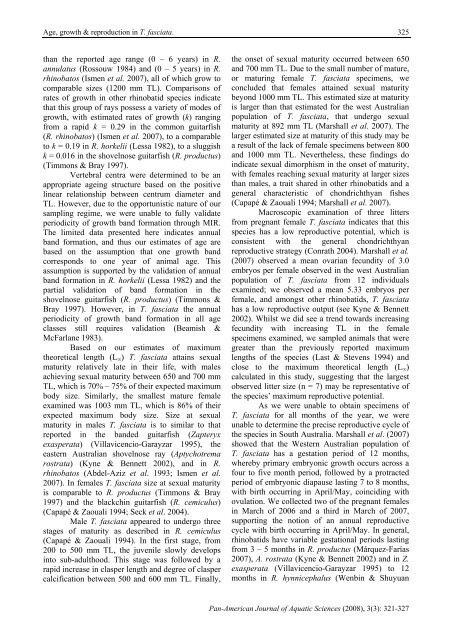Initial assessment of age, growth and reproductive ... - PanamJAS
Initial assessment of age, growth and reproductive ... - PanamJAS
Initial assessment of age, growth and reproductive ... - PanamJAS
You also want an ePaper? Increase the reach of your titles
YUMPU automatically turns print PDFs into web optimized ePapers that Google loves.
Age, <strong>growth</strong> & reproduction in T. fasciata.325than the reported <strong>age</strong> range (0 – 6 years) in R.annulatus (Rossouw 1984) <strong>and</strong> (0 – 5 years) in R.rhinobatos (Ismen et al. 2007), all <strong>of</strong> which grow tocomparable sizes (1200 mm TL). Comparisons <strong>of</strong>rates <strong>of</strong> <strong>growth</strong> in other rhinobatid species indicatethat this group <strong>of</strong> rays possess a variety <strong>of</strong> modes <strong>of</strong><strong>growth</strong>, with estimated rates <strong>of</strong> <strong>growth</strong> (k) rangingfrom a rapid k = 0.29 in the common guitarfish(R. rhinobatos) (Ismen et al. 2007), to a comparableto k = 0.19 in R. horkelii (Lessa 1982), to a sluggishk = 0.016 in the shovelnose guitarfish (R. productus)(Timmons & Bray 1997).Vertebral centra were determined to be anappropriate <strong>age</strong>ing structure based on the positivelinear relationship between centrum diameter <strong>and</strong>TL. However, due to the opportunistic nature <strong>of</strong> oursampling regime, we were unable to fully validateperiodicity <strong>of</strong> <strong>growth</strong> b<strong>and</strong> formation through MIR.The limited data presented here indicates annualb<strong>and</strong> formation, <strong>and</strong> thus our estimates <strong>of</strong> <strong>age</strong> arebased on the assumption that one <strong>growth</strong> b<strong>and</strong>corresponds to one year <strong>of</strong> animal <strong>age</strong>. Thisassumption is supported by the validation <strong>of</strong> annualb<strong>and</strong> formation in R. horkelii (Lessa 1982) <strong>and</strong> thepartial validation <strong>of</strong> b<strong>and</strong> formation in theshovelnose guitarfish (R. productus) (Timmons &Bray 1997). However, in T. fasciata the annualperiodicity <strong>of</strong> <strong>growth</strong> b<strong>and</strong> formation in all <strong>age</strong>classes still requires validation (Beamish &McFarlane 1983).Based on our estimates <strong>of</strong> maximumtheoretical length (L ∞ ) T. fasciata attains sexualmaturity relatively late in their life, with malesachieving sexual maturity between 650 <strong>and</strong> 700 mmTL, which is 70% – 75% <strong>of</strong> their expected maximumbody size. Similarly, the smallest mature femaleexamined was 1003 mm TL, which is 86% <strong>of</strong> theirexpected maximum body size. Size at sexualmaturity in males T. fasciata is to similar to thatreported in the b<strong>and</strong>ed guitarfish (Zapteryxexasperata) (Villavicencio-Garayzar 1995), theeastern Australian shovelnose ray (Aptychotremarostrata) (Kyne & Bennett 2002), <strong>and</strong> in R.rhinobatos (Abdel-Aziz et al. 1993; Ismen et al.2007). In females T. fasciata size at sexual maturityis comparable to R. productus (Timmons & Bray1997) <strong>and</strong> the blackchin guitarfish (R. cemiculus)(Capapé & Zaouali 1994; Seck et al. 2004).Male T. fasciata appeared to undergo threest<strong>age</strong>s <strong>of</strong> maturity as described in R. cemiculus(Capapé & Zaouali 1994). In the first st<strong>age</strong>, from200 to 500 mm TL, the juvenile slowly developsinto sub-adulthood. This st<strong>age</strong> was followed by arapid increase in clasper length <strong>and</strong> degree <strong>of</strong> claspercalcification between 500 <strong>and</strong> 600 mm TL. Finally,the onset <strong>of</strong> sexual maturity occurred between 650<strong>and</strong> 700 mm TL. Due to the small number <strong>of</strong> mature,or maturing female T. fasciata specimens, weconcluded that females attained sexual maturitybeyond 1000 mm TL. This estimated size at maturityis larger than that estimated for the west Australianpopulation <strong>of</strong> T. fasciata, that undergo sexualmaturity at 892 mm TL (Marshall et al. 2007). Thelarger estimated size at maturity <strong>of</strong> this study may bea result <strong>of</strong> the lack <strong>of</strong> female specimens between 800<strong>and</strong> 1000 mm TL. Nevertheless, these findings doindicate sexual dimorphism in the onset <strong>of</strong> maturity,with females reaching sexual maturity at larger sizesthan males, a trait shared in other rhinobatids <strong>and</strong> <strong>age</strong>neral characteristic <strong>of</strong> chondrichthyan fishes(Capapé & Zaouali 1994; Marshall et al. 2007).Macroscopic examination <strong>of</strong> three littersfrom pregnant female T. fasciata indicates that thisspecies has a low <strong>reproductive</strong> potential, which isconsistent with the general chondrichthyan<strong>reproductive</strong> strategy (Conrath 2004). Marshall et al.(2007) observed a mean ovarian fecundity <strong>of</strong> 3.0embryos per female observed in the west Australianpopulation <strong>of</strong> T. fasciata from 12 individualsexamined; we observed a mean 5.33 embryos perfemale, <strong>and</strong> amongst other rhinobatids, T. fasciatahas a low <strong>reproductive</strong> output (see Kyne & Bennett2002). Whilst we did see a trend towards increasingfecundity with increasing TL in the femalespecimens examined, we sampled animals that weregreater than the previously reported maximumlengths <strong>of</strong> the species (Last & Stevens 1994) <strong>and</strong>close to the maximum theoretical length (L ∞ )calculated in this study, suggesting that the largestobserved litter size (n = 7) may be representative <strong>of</strong>the species’ maximum <strong>reproductive</strong> potential.As we were unable to obtain specimens <strong>of</strong>T. fasciata for all months <strong>of</strong> the year, we wereunable to determine the precise <strong>reproductive</strong> cycle <strong>of</strong>the species in South Australia. Marshall et al. (2007)showed that the Western Australian population <strong>of</strong>T. fasciata has a gestation period <strong>of</strong> 12 months,whereby primary embryonic <strong>growth</strong> occurs across afour to five month period, followed by a protractedperiod <strong>of</strong> embryonic diapause lasting 7 to 8 months,with birth occurring in April/May, coinciding withovulation. We collected two <strong>of</strong> the pregnant femalesin March <strong>of</strong> 2006 <strong>and</strong> a third in March <strong>of</strong> 2007,supporting the notion <strong>of</strong> an annual <strong>reproductive</strong>cycle with birth occurring in April/May. In general,rhinobatids have variable gestational periods lastingfrom 3 – 5 months in R. productus (Márquez-Farías2007), A. rostrata (Kyne & Bennett 2002) <strong>and</strong> in Z.exasperata (Villavicencio-Garayzar 1995) to 12months in R. hynnicephalus (Wenbin & ShuyuanPan-American Journal <strong>of</strong> Aquatic Sciences (2008), 3(3): 321-327
















